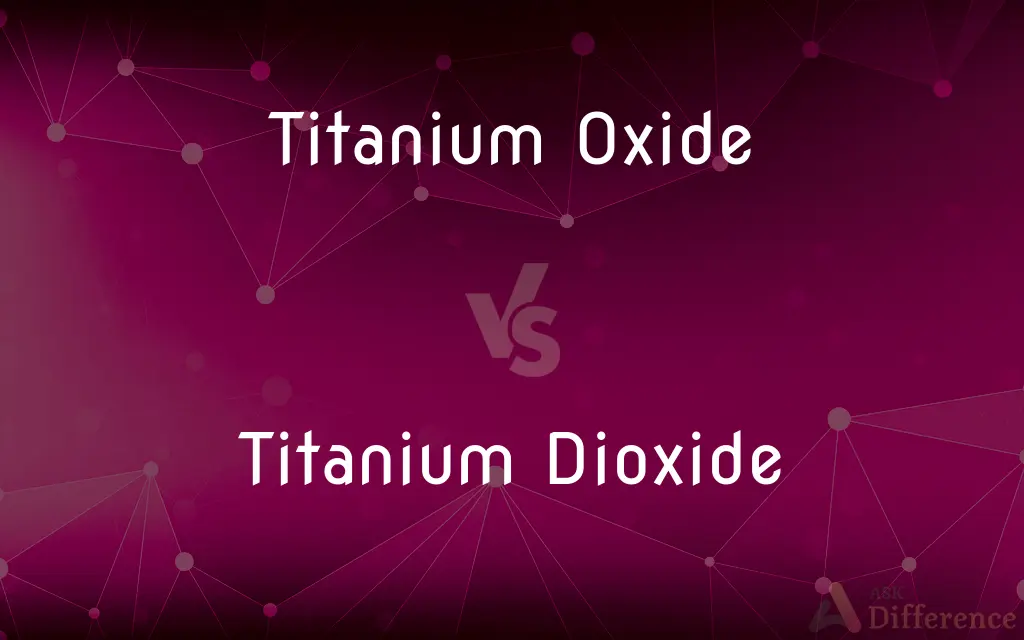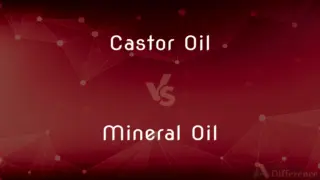Titanium Oxide vs. Titanium Dioxide — What's the Difference?
By Tayyaba Rehman — Published on November 16, 2023
Titanium Oxide generally refers to oxides of titanium without specifying the oxidation state. Titanium Dioxide, TiO₂, specifically has one titanium atom to two oxygen atoms. Their properties and applications differ.

Difference Between Titanium Oxide and Titanium Dioxide
Table of Contents
ADVERTISEMENT
Key Differences
General Terminology: Titanium Oxide is a broader term, encompassing various oxides of titanium with different oxygen content. Conversely, Titanium Dioxide refers to a specific compound with the formula TiO₂.
Chemical Composition: While Titanium Oxide can denote any oxide of titanium, Titanium Dioxide is a particular compound wherein every titanium atom is paired with two oxygen atoms. It's essential to understand that Titanium Dioxide is a type of Titanium Oxide, but not every Titanium Oxide is Titanium Dioxide.
Applications: Titanium Oxide, as a general term, doesn't pinpoint a specific use since it can relate to different compounds. In contrast, Titanium Dioxide is widely used in industries such as paints, cosmetics, and sunscreens due to its bright whiteness and UV-resistant properties.
Physical Properties: Titanium Dioxide is recognized for its white pigment and is a powdery solid. Depending on the specific type and oxidation state, Titanium Oxides might vary in appearance and properties.
Occurrence: Titanium Dioxide occurs naturally in several minerals. Titanium Oxide, being a more generic term, may refer to multiple naturally occurring or synthetically produced compounds.
ADVERTISEMENT
Comparison Chart
Specificity
General term for titanium oxides
Specific compound with formula TiO₂
Chemical Formula
Varies
TiO₂
Common Use
Depends on the specific oxide
Paints, sunscreens, and cosmetics
Appearance
Can vary
White powdery solid
Occurrence
Multiple natural/synthetic occurrences
Found in minerals like rutile, anatase, and brookite
Compare with Definitions
Titanium Oxide
Oxides of titanium with varying oxygen content.
Different forms of Titanium Oxide exhibit distinct reactivities.
Titanium Dioxide
Popular in sunscreens for UV protection.
The sunscreen's efficacy is enhanced with Titanium Dioxide.
Titanium Oxide
Titanium's reaction product with oxygen.
Upon oxidation, the titanium sample transformed into Titanium Oxide.
Titanium Dioxide
The compound with the chemical formula TiO₂.
Through spectral analysis, they confirmed the presence of Titanium Dioxide.
Titanium Oxide
Broad term encompassing various titanium-oxygen compounds.
They studied the photoactivity across multiple Titanium Oxide forms.
Titanium Dioxide
A naturally occurring mineral in rutile and anatase.
Miners extracted significant quantities of Titanium Dioxide from the ore.
Titanium Oxide
A compound formed from titanium and oxygen.
The research focused on the unique properties of Titanium Oxide.
Titanium Dioxide
An inorganic substance with high refractive index.
Due to its refractive properties, Titanium Dioxide is used in certain optical applications.
Titanium Oxide
Compound with potential applications in electronics and photovoltaics.
Researchers are exploring Titanium Oxide's efficacy in solar cells.
Titanium Dioxide
A white pigment used in various industries.
Titanium Dioxide provides the paint with its bright white hue.
Common Curiosities
How do Titanium Oxide and Titanium Dioxide differ?
Titanium Oxide is a general term for titanium's oxides, while Titanium Dioxide specifies the TiO₂ compound.
Is Titanium Dioxide safe in cosmetics?
Yes, Titanium Dioxide is deemed safe in cosmetics and is often used for its pigmenting properties.
Are they both naturally occurring?
Titanium Dioxide is found in nature. Titanium Oxide can refer to multiple forms, some of which are natural.
Can Titanium Oxide be used as a term for TiO₂?
While TiO₂ is a type of Titanium Oxide, the latter can refer to other compounds, so specificity is essential.
Why is Titanium Dioxide added to food?
It's added as a white pigment to some foods.
Can Titanium Oxide be a photocatalyst?
Certain forms of Titanium Oxide, especially TiO₂, are used as photocatalysts.
What gives Titanium Dioxide its white color?
Its crystalline structure and high refractive index contribute to its bright whiteness.
How do their chemical properties differ?
They differ based on their oxidation states and structure.
Are there health concerns associated with them?
Titanium Dioxide is generally considered safe, but inhalation of its powdered form should be avoided.
How is Titanium Dioxide produced?
It's extracted from ores and then refined.
Which is used in sunscreen?
Titanium Dioxide is commonly used in sunscreens for its UV-resistant properties.
Are they expensive?
Costs can vary, but Titanium Dioxide is relatively inexpensive.
Are they used in electronics?
Titanium Oxide, especially certain forms, has applications in electronics and photovoltaics.
Can they be harmful to the environment?
Concerns exist over nano-sized Titanium Dioxide particles, but in general, it's considered low risk.
What is the primary use of Titanium Dioxide?
It's widely used as a white pigment in paints, coatings, and cosmetics.
Share Your Discovery

Previous Comparison
Have Been vs. Has Been
Next Comparison
Castor Oil vs. Mineral OilAuthor Spotlight
Written by
Tayyaba RehmanTayyaba Rehman is a distinguished writer, currently serving as a primary contributor to askdifference.com. As a researcher in semantics and etymology, Tayyaba's passion for the complexity of languages and their distinctions has found a perfect home on the platform. Tayyaba delves into the intricacies of language, distinguishing between commonly confused words and phrases, thereby providing clarity for readers worldwide.













































